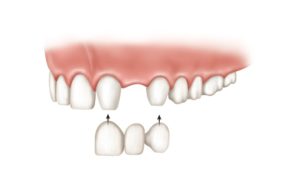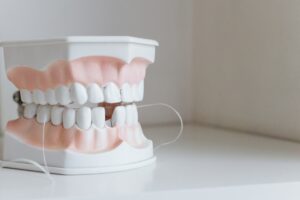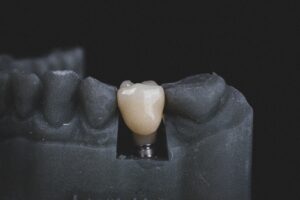
Dentistry is making huge advancements on a daily basis causing the expense of dental treatment to increase with these advancements. A dental bridge is one of the cosmetic treatment methods people are opting for nowadays. The dental team at the Lane and Associates is making a great difference in people’s lives by restoring their beautiful smiles with dental bridges.
A dental bridge is a prosthetic tooth that is fabricated to replace a missing tooth or fill a gap that forms due to the extraction of teeth. According to the Lane DDS, some bridges replace just one tooth, and some bridges replace a set of teeth. The expert dentists at the Lane and Associates will use dental bonding to join the dental bridge to teeth.
Dental bridges are known as one of the most natural appearing replacements for missing teeth. Since the dental bridge gives such a real look the cost of the dental bridge also varies according to the kind of material used in the composition of the dental bridge.
Are Dental Bridges Expensive?
The cost of a dental bridge is determined by the time consumption of the procedure and the material used in the fabrication. The cost of dental bridges depending on a factory:
- Location
- Anesthetic if required
- Number of teeth needed to fill the gap
The placement of the Dental bridges is an affordable tooth replacement option, and if you have dental insurance the costs reduce significantly. The cost of the bridges varies between $300 and $1,000 to replace a single tooth. The cost varies according to the material of the bridge. For example you must pay more for an all-porcelain bridge than for a metal or porcelain-fused bridge.
If your dentist recommends a cantilever bridge or plans for extensive work on your remaining teeth to support the bridge, always remember that in such cases your costs may be higher.
How Much Do Dental Bridges Cost Without Insurance?
Did you know that if you have no insurance, you will be accountable for paying the full cost of the dental bridge plus the cost for other treatment that is required along with the dental bridge? During the treatment of dental bridges, the cost includes the required X-rays before the procedure, and after the procedure and possibly additional treatments. The additional treatment may include addressing dental issues such as gum problems or dental caries.
If the patient chooses the option of a dental implant-supported bridge without the coverage of insurance, then the patient will be responsible to pay all the charges. If your dentist finds that you need extra dental bridges, that will be your financial responsibility without insurance as well.
Does Insurance Cover a Dental Bridge?
If you are thinking about getting a fixed prosthesis then having insurance will save you tons of money. The dental bridges are covered with insurance; however, you can consult with our dentists at Lane and Associates Family Dentistry regarding details of the treatment plan and insurance coverage.
Some insurance plans have changed their eligibility and excluded pre-existing conditions. The insurance policy that you have may also require a waiting period of up to one year.
Before opting the dental treatment, you must have a complete understanding of insurance coverage so that you are assured of receiving the most affordable option for your dental bridge.
If you or your loved one is looking for restorative dental treatment here is good news! The cost of bridges will be substantially less with insurance coverage. Insurance can cover up to 50% of dental bridges. Lane and Associates Family Dentistry can help you to understand your financial responsibility with insurance. All you need to do is consult with our dentists or get in contact with your insurance provider to confirm the maximum limits and copays of the insurance.

Do Different Types of Dental Bridges Cost More than Others?
The cost of different types of dental bridges varies from each other. It is estimated to range from $1,500 to $5,000; it completely depends on the type of dental bridge you select. Following are some of the costs of the dental bridge:
- $2,000 – $5,000 are the charges for a traditional dental bridge. It has a pontic and a crown for each abutment tooth.
- $1,500 and $2,500 is the cost for Maryland teeth bridges with one pontic.
- $2000 to $2,700 will have the range for a cantilever bridge.
- $5,000 – $15,000 is the cost for an implant-supported bridge, a bridge with two dental implants spanning three or four teeth.
This can be affordable when you have dental insurance as it will help pay for tooth bridges and other specific dental treatment options.
What Causes the Price to Go Up for Dental Bridges?
Before pursuing dental bridges, it is vital to know about the different factors that can affect dental bridge cost. Following are some of the factors that should be kept in mind while getting dental bridgework done.
- Number of Teeth That Require Replacing
- Materials Used for the Dental Bridges, including zirconia, all-ceramic, or porcelain-fused-to-metal. The type of material you choose can impact the amount you will need to pay.
- The dental crown and traditional bridges fabrication method can also impact the price of a dental bridge.
- Type of Dental Bridges: Several different types of dental bridges are available such as Maryland bridges, Cantilever bridges, Implant-supported bridges.
When you have an idea about all the above-mentioned factors you can easily make the right decision about your oral health along with your dentist at Lane and Associates Family Dentistry.
Are Bridges Cheaper than Implants?
Yes, Dental Bridges usually cost less than dental implants. If a dental bridge is properly cleaned with a toothbrush and rinsing it can stay for a lifetime. Our Lane DDS will make sure that you’ll have a lasting smile with our durable and natural-looking bridges.















